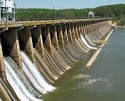 Exelon Corp. has pledged in a deal announced Monday to work to enhance spawning fish passage at Conowingo Dam over the next 50 years, seeking to revive the Susquehanna River’s meager stocks of American shad and river herring. The Chicago-based company and the U.S. Fish and Wildlife Service said they had reached agreement to improve at least one of two fish lifts at Conowingo and meanwhile start trucking migratory shad and river herring upriver past it and three other dams in Pennsylvania.
Exelon Corp. has pledged in a deal announced Monday to work to enhance spawning fish passage at Conowingo Dam over the next 50 years, seeking to revive the Susquehanna River’s meager stocks of American shad and river herring. The Chicago-based company and the U.S. Fish and Wildlife Service said they had reached agreement to improve at least one of two fish lifts at Conowingo and meanwhile start trucking migratory shad and river herring upriver past it and three other dams in Pennsylvania.
The agreement comes after years of negotiations between the company and wildlife agencies and conservation groups, which were seeking to revive the once-legendary spawning runs of shad and herring. The number of returning fish each spring has been trending downward since the 1980s, and wildlife agencies and conservationists wanted Exelon to make potentially costly upgrades to fish lifts there as a condition of renewing its federal license to operate the hydroelectric facility.
The company’s license to operate Conowingo expired in 2014, but the Federal Energy Regulatory Commission has extended the permit while the parties — including Maryland —attempt to hash out their differences. An even more contentious issue involves what Exelon may have to do about the buildup of nutrient-laden sediment in the dam’s reservoir, which studies have shown could complicated efforts to restore the Chesapeake Bay’s water quality.
Ron DeGregorio, president of Exelon Power and senior vice president of Exelon Generation, called the fish passage agreement a “significant step” toward the goal of reviving spring shad and herring runs.
“The trap and transport program allows fish to bypass Holtwood, Safe Harbor and York Haven Dams to successfully reach their spawning grounds,” DeGregorio pointed out. As part of the deal, Exelon pledged to truck as many as 100,000 of each species annually past all four dams.
American shad and river herring, which once played a prominent role in the fishing economy and culture in the Chesapeake region, are far less abundant in the Bay’s largest tributary than they were before Conowingo was built in 1928. Shad and river herring once swam far upriver every spring to spawn, and in the 18th and 19th centuries fishermen netted them by the millions.
In earlier attempts to reverse the declines, Conowingo’s operators built lifts in 1972 and 1991 to hoist migrating fish up and over the 94-foot dam. The elevators seemed to work for a while, and the number of American shad passed upriver peaked at 193,000 in 2001. The tally has been declining since, with a record low of just 8,341 picked up last spring.
As of April 23 this year, 2,916 had passed over Conowingo, according to the Pennsylvania Fish and Boat Commission, with the usual peak of spawning not expected until May.
The wildlife service and other interested parties have set a goal of restoring 2 million shad and 5 million herring to spawning grounds above all the dams.
“This is a victory for everyone who lives or recreates on the Susquehanna River and the Chesapeake Bay,” said Wendi Weber, Northeast regional director for the federal wildlife service. “The agreement honors the science-based recommendations developed by the federal and state agencies that manage these resources.”
The agreement not only requires immediate steps to boost passage, but also provides for adjusting those efforts as the fish population grows, or if they aren’t producing the expected results. Computer modeling will be used to upgrade Conowingo’s two existing fish lifts, according to a joint release.
Karis King, spokeswoman for the Maryland Department of Natural Resources, called the deal a “practical agreement.”
Tara Moberg, freshwater scientist with The Nature Conservancy, said the agreement is better than earlier ones, because it incorporates “performance-based” requirements rather than prescribing particular improvements that may not work. As a first step, she noted, the company will have to figure out how to attract more fish upriver to the dam’s its existing lifts.
Bill Goldsborough, senior fisheries scientist with the Chesapeake Bay Foundation, also praised the agreement, saying that trapping and trucking fish is “an important part of a long-term recovery strategy,” but one he hopes is still a temporary solution.
“We’re hopeful that the stocks will grow and pass (the dam) by the scale that you can’t cover with trap and truck,” Goldsborough added. Ultimately, he said, his group would like to see sufficient fish lifts or other passage facilities be installed so that shad and herring “have free run of the river.”
The agreement also incorporates American eel restoration efforts already outlined in a separate license Exelon has to operate the Muddy Run Pumped Storage Facility near Conowingo. Eels will be trapped and trucked upriver through at least 2030, after which a new structure will be built to aid in their passage. The interest in reviving eels in the river is two-fold: As they migrate upstream, they distribute freshwater mussels that collectively can filter millions of gallons of water daily.
